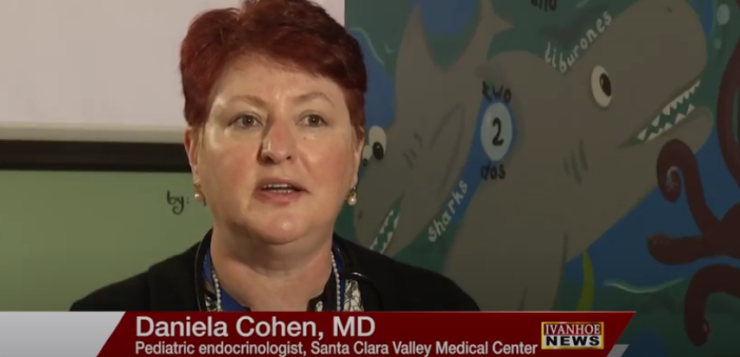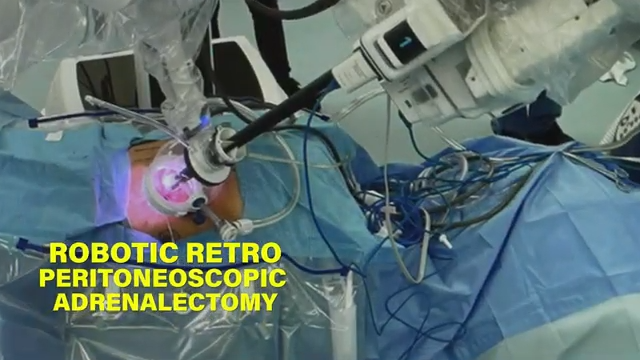Daniela Cohen, MD, a pediatric endocrinologist at Santa Clara Valley Medical Center, talks about a new way to monitor diabetes in infants.
COHEN: A blood sugar is low, it’s a pretty intensive two or three days teach. Then they go home and they start checking the blood sugar before each meal, at bedtime too, giving insulin when required. We teach them how to calculate, how to count carbohydrates, and after a few days, they come for a first clinic visit with me. We are in touch over the phone every single day after they go home from the hospital to see how they’re doing. Eventually we space out the visits every two or three months. If kids are enrolled in school or day care, the day care teachers, caretaker need to learn also how to treat diabetes, what to do in situations that need intervention, such as high or low blood sugars.
Is it more serious in an infant than it is in an adult?
COHEN: In an infant. Most people would know and tell others if they feel low blood sugar. Low blood sugar, you feel shaky, you feel hungry, you can have a headache, you can have a bellyache, all kinds of symptoms. Now, if an infant has those symptoms, they cannot express themselves, the infants. The parents wouldn’t know when something is wrong. So, you, as a parent, you are in a state of constant frenzy and, you know, awareness that something might go wrong every single moment and you wouldn’t know and that’s pretty tough.
Diabetes is more serious when it’s an infant?
COHEN: Right. So, an infant with type one diabetes cannot express the feelings of hunger or feeling a headache or a bellyache or any other feelings that the baby doesn’t feel well. It’s really hard for the parents to gauge what’s happening, and they live in a state of constant anxiety and fear that the baby might have a low blood sugar they wouldn’t catch in time or a high blood sugar they wouldn’t catch in time. So, most parents at this age would do a fingerstick 10 to 20 times a day, they probably wouldn’t sleep at night at all. They will wake up every minute to check on the baby, to see the baby’s breathing, if the baby has a good blood sugar, and it’s a pretty tough situation for them.
What’s the worst-case scenario then?
COHEN: If the baby has a very low blood sugar that isn’t caught in time, they might seize or they might lose consciousness, and if that’s not treated in time, again, they might even die. There were cases of death from a hypoglycemic event.
What are the symptoms? How is it diagnosed?
COHEN: So, in such a small baby, the parents need to be very attentive, very astute to see every single sign that something is off and every single sign that feels off, they need to check the blood sugar. If the blood sugar is below 70, they need to give the baby something sweet to drink or eat and if the baby loses consciousness or has a seizure, then we have a special injection called glucagon. They need to administer through their clothes into the thigh, it’s a saving hormone, it’s a hormone that opposes insulin and basically it’s like a resuscitation hormone for kids for, you know, hypoglycemic coma or having a seizure because of hypoglycemia. If they would need to use that shot, though, they would need to call 911 immediately and the baby would need to be admitted in the hospital.
Tell me about the sensor, why is it so revolutionary?
COHEN: So, this is a baby who was admitted that eight months of age. Basically, she is the youngest patient with type one diabetes that I ever took care of. Just to put things in perspective, kids who are diagnosed with diabetes until age six months of age are considered neonatal diabetes, and most of them have transitory diabetes. It’s an inherited type of insulin of diabetes and they would get rid of their diabetes within weeks or months. Those are the good news. She was just on the cusp at the age of eight months. Basically, we couldn’t say she has neonatal and, unfortunately, she will have diabetes all her life and she had positive antibodies for type one. This sensor is a sensor that’s inserted under the skin, checks the blood sugar every five minutes, and puts it on a screen for the parents. They have this screen next to their bed when they go to bed. They have this screen next to them all day and when the blood sugar goes under, say, 80 or 90, we can set an alarm, so they know immediately when something goes wrong, and they need to tend to the baby. The same for high blood sugar. If the high blood sugar trends up, it goes towards 300 or above, they know they need to give some insulin and to attend the baby again.
How is it a game changer?
COHEN: So, if you have this kind of sensor called Dexcom G6, you only need to change it every 10 days. Basically, it’s a stick for the baby every 10 days as opposed to 10 to 20 finger sticks a day and it starts working two hours after you insert it. It’s very reliable. The numbers from the meter that they’re using usually are very corresponding, they’re like the same with the ones on the sensor. So, it’s very trustworthy and the other thing is it doesn’t fall off, it stays on. Other sensors, they fall off after a couple of days or they don’t work anymore after a couple of days, this one works for the full 10 days. So, I like it very much and most of my patients that we are putting them on they like it, they want to continue to use it.
Does it give you more information?
COHEN: Yeah, it also allows me to see the trends. As a practitioner I look at the numbers, we’d like all the blood sugars to be under 200. Basically, what that means is we want between 80 to 200 to have a good control of the diabetes. If we see that the baby, say, wakes up every day with the blood sugar of 250 and I look at the pattern and I say, oh, this blood sugar is too high, we need to give a little bit more insulin through the night or after meals. The blood sugar is very high or sometimes it’s very low. Depending on those patterns, I take a decision and I reduce or increase the dose of insulin. So, it’s very helpful. When we check only with a fingerstick, we only have specific points that we check. We only have four points throughout the day that we see where the blood sugars are. With this sensor, we see the entire day. We see everything that happens throughout the day.
Does Peyton, the baby, ever have to use the prick method or does she just always use the sensor?
COHEN: Well, once in a while we encourage the parents, if the sensor shows very low numbers or very high, to use a finger stick just to ascertain that’s indeed the case. In the very low numbers, sometimes it’s not as accurate as it’s supposed to be. So, say if the blood sugar it shows as 50 and the baby shows no signs, they should do a fingerstick. So just to make sure they don’t treat a low blood sugar when it’s not a real low blood sugar.
Did she ever have to do the traditional method?
COHEN: Of course. Yeah, they know how to do that, and they do it once in a while. They have to use it once in a while. It doesn’t completely absolve you of finger sticks. They need to have it.
When she was first diagnosed, did she immediately use this sensor?
COHEN: So, what happens is when she was admitted, as soon as I knew she was admitted, I contacted the rep for the company, the Dexcom company, and I told her she needs to do an exception for this baby to make sure the baby gets out of the hospital on a sensor within two days. Usually, it takes a while for the insurance to approve, to get the sensor, to get all the stuff done. The usual wait time is months, actually, for most of my patients. This baby went home within three days with a sensor on her. We made it happen.
How has Peyton improved?
COHEN: Peyton is doing very, very well. Her hemoglobin A1C, which basically shows how her blood sugars, have been in the past three months one of the best of all my patients. It’s 6.8. It’s basically exactly at target for a baby is only now one and a half years old. It’s awesome. Her parents are really good. They’re doing a really good job with the pump. She also is on an insulin pump now. So, with a sensor and a pump, it works really well for her.
The pump is separate, it’s not related?
COHEN: This particular pump is a different pump, it doesn’t communicate with the sensor because we have pumps now that communicate with the sensor. However, the sensor that would communicate to this pump specifically is a little bit too chunky and the needle is too big for the size of a baby, so we decided to wait on that sensor.
Do you think it was easier to get her on target using this sensor than it would’ve been using the traditional method?
COHEN: Oh, yeah, for sure. As I said, we have information 24/7 and we know exactly what’s happening every single moment. Her mother is also a nurse, she understands diabetes very well. Sometimes she makes changes without even consulting with me and I trust her to do that. She informs me afterwards. If she feels she’s turning too low at a certain time or too high, she takes decisions, and that’s OK with me. I mean, if she’s doing a good job, she can do that by herself. She knows exactly what Peyton needs.
What are the warning signs for the doctors and parents that the infant would possibly have type one diabetes?
COHEN: In infants, it’s very hard to diagnose diabetes because they’re not potty trained. You know, an older child who is potty trained the first sign could be starting to wet the bed at night. I had a lot of patients that, all of a sudden, after one or two or three years of being potty trained, they start having what’s called, in medical lingo, nocturnal enuresis, that they pee in their bed two or three times a night, or if they don’t pee, they wake up two or three times a night to go pee. That could be the first sign of diabetes. Also, daytime, they’re extremely thirsty because, again, when they have high blood sugars, they need to pee all that sugar and they need to pee with water, so they pee 10 times a day and drink gallons of water. So, in a baby, again, they eat a lot of times and it’s mostly formula and it’s really hard to gauge they’re thirsty or more thirsty than they’re supposed to be and it takes a long time till they’re diagnosed. This mother was very astute. She saw that the baby is not doing well. She was actually pretty sick when she came in, very pale, lost a lot of weight. One of the signs is also weight loss or not enough weight gain because an infant needs to gain a lot of weight in the first year of life and she didn’t. So, weight loss, peeing a lot, multiple diapers that need to be changed through the day, diapers that are soaked and urine goes through. Those are signs of diabetes.
Is there anything else that you want to touch upon?
COHEN: Recently I had a lot of new patients with diabetes, and it seems that COVID is really hard on all the families, the kids are mainly at home, they do no exercise, they drink a lot of milk, soda, juices. Last week I had a patient who gained 50 pounds in the past year. I had double the number of kids with type two diabetes in the past few months that I used to have before. So, one thing the parents need to keep in mind that even though we are still in COVID, they can still go to the park, they can go out, walk or play by themselves in the backyard or outside in a park, not necessarily with other kids. Also, they need to watch out what they drink and what they eat. Cut off on the soda, cut off on the milk too. Milk, after age two, it’s not necessary but for breakfast. After breakfast, they don’t need to drink milk with lunch or with dinner or at bedtime.
Now, is that more type two diabetes?
COHEN: More for type two, but recently kids here in this area have type two. They don’t have type one. We have a lot of kids who have type two diabetes. and some of them, they need to start on insulin straight off the bat because their pancreas does not have any more reserves, I mean, so then they need to start them on insulin. So that’s why it’s something for the community to keep in mind that we need to drink less soda, less
What is the name of the sensor?
COHEN: This particular sensor we’re using with her it’s called Dexcom G6, it’s basically sixth generation. There are a few other sensors on the market we use less, either because they’re chunkier or they don’t last for the full amount of time they’re supposed to. One of them, which is supposed to be for 14 days, needs to be read by a reader every time we want to know a blood sugar. So, in the end, we end up having only four points or six points. Basically, when the parent comes in with a reader, we have a point. So, it’s not as good as the Dexcom.
Interview conducted by Ivanhoe Broadcast News.
END OF INTERVIEW
This information is intended for additional research purposes only. It is not to be used as a prescription or advice from Ivanhoe Broadcast News, Inc. or any medical professional interviewed. Ivanhoe Broadcast News, Inc. assumes no responsibility for the depth or accuracy of physician statements. Procedures or medicines apply to different people and medical factors; always consult your physician on medical matters.
If you would like more information, please contact:
PATTY PORTER
PATRICIA.PORTER@HHS.SCCGOV.ORG
408-885-4006
Sign up for a free weekly e-mail on Medical Breakthroughs called First to Know by clicking here





